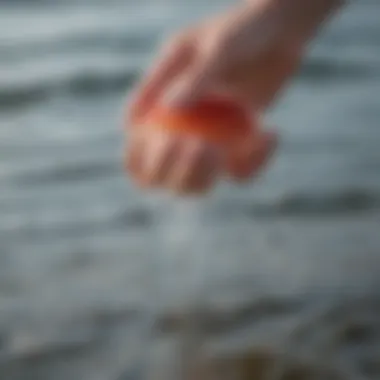Comprehensive Guide to Treating Jellyfish Stings Effectively


Intro
Jellyfish stings can be a real pain, quite literally. Consider this: you’re swimming in calm waters, enjoying a day out. Suddenly, a jellyfish glides by, and before you even know it, you’re left with a burning, stinging sensation. The truth is, understanding how to handle such encounters can make all the difference, both in terms of immediate relief and long-term health.
To tackle this unique issue, it’s essential to grasp the biology of a jellyfish and the mechanism behind its sting. With a multitude of species inhabiting our oceans—some more dangerous than others—being informed can help you navigate these waters more safely. This guide digs into various areas, covering essential techniques for handling stings, gear recommendations to minimize risk, and precautionary measures that enthusiasts should adopt while enjoying aquatic activities.
The ultimate goal here isn't just to resolve the immediate discomfort but also to ensure that you can keep diving, swimming, or paddleboarding without fear of the next encounter. Let's break down everything you need to know for a smoother and safer experience in the water.
Understanding Jellyfish and Their Stings
Understanding jellyfish and their stings is crucial for anyone venturing into marine activities. Not only do these intriguing creatures inhabit our oceans, but their stings can deliver both pain and complications. Recognizing the types of jellyfish and their behaviors can significantly enhance your safety during water sports.
Knowledge of jellyfish anatomy and their mechanisms of stinging helps in crafting effective responses once a sting occurs. This knowledge empowers not just professional instructors but also casual enthusiasts to make informed decisions, potentially reducing the risk of severe reactions. Furthermore, understanding the common jellyfish species in your area allows for better preparedness in case of encounters.
Understanding jellyfish is not just about the sting; it's also about appreciating their ecological significance. These creatures are an essential part of marine ecosystems, forming the base of food chains and influencing various predator species. Therefore, a deeper understanding can foster respect for marine life, encouraging protective attitudes toward ocean conservation.
Anatomy of a Jellyfish
Jellyfish are fascinating organisms. Their bodies are mostly made up of water, with a gelatinous consistency. A typical jellyfish has a bell-shaped umbrella and tentacles, which are equipped with specialized cells called cnidocytes. These cells house venom-filled nematocysts that trigger the painful sting.
The umbrella can pulse, propelling the jellyfish through the water. Their tentacles can extend several feet, enabling them to capture prey or deter predators.
Key Features:
- Bell-Capsule: The main body structure allowing movement.
- Tentacles: Used for capturing prey and defense.
- Cnidocytes: Specialized cells that release venom upon contact.
Understanding the anatomy of a jellyfish is not merely scientific; it equips individuals with essential skills for identification in the wild, which is critical during outdoor activities.
Types of Jellyfish Commonly Encountered
Several species of jellyfish are frequently spotted in coastal waters - some are harmless while others can pose serious risks.
- Moon Jellyfish (Aurelia aurita): Commonly found in coastal waters, known for its translucent bell and usually mild sting.
- Box Jellyfish (Chironex fleckeri): Found in tropical waters, notorious for its venom; a sting can be fatal.
- Portuguese Man o' War (Physalia physalis): Often mistaken for a jellyfish, this colonial organism has long tentacles that can inflict painful stings.
Being aware of these types and their characteristics could help enthusiasts remain vigilant and informed.
Mechanism of a Jellyfish Sting
The mechanism behind a jellyfish sting is a sophisticated process. When a jellyfish comes into contact with skin, the tentacles extend, delivering its stinging cells into the skin.
This is how it works:
- Trigger: The mere touch initiates the release of venom through nematocysts.
- Venom Action: The venom can affect the skin, nerves, and even interfere with cardiovascular functions in severe cases.
- Reactions: Depending on the jellyfish species, stings can cause anything from mild irritation to intense pain and systemic reactions like anaphylaxis.
It's pivotal for water sports enthusiasts to have this knowledge, enabling them to act quickly if stung, thereby mitigating risks and ensuring a safer experience in the water.
Recognizing Symptoms of Jellyfish Stings
Recognizing the symptoms of jellyfish stings is crucial for timely and effective management. Understanding the nuances of these symptoms can make a world of difference between a minor inconvenience and a serious medical emergency. When someone suffers a jellyfish sting, the initial response of the body can vary significantly based on both the species of jellyfish and the individual's health condition.
Initial Reaction and Pain


The moment a jellyfish tentacle makes contact, many people describe a sharp, burning pain that feels like a sudden jolt. This initial reaction can be nearly instantaneous, often catching the victim off guard. It’s important to note the specific location of the sting, as this can guide the next steps in treatment.
- Common sensations include:
- Immediate sharp pain, which can be likened to a bee sting.
- A burning sensation that may extend beyond the sting area.
- Red welts or rashes appearing on the skin, often the hallmark symptoms of a jellyfish sting.
As the pain sets in, affected individuals may also experience:
- Swelling around the sting site, which can indicate a more severe reaction.
- Nausea or dizziness, which could point toward an allergic reaction, particularly in sensitive individuals.
This initial stage is critical, as many folks might underestimate the seriousness of these symptoms perceiving them as a mere annoyance. However, recognizing them properly can pave the way for swift action.
Severe Reactions: Anaphylaxis and Other Risks
While many stings result in mild to moderate reactions, severe cases can escalate quickly. Anaphylaxis, a life-threatening allergic reaction, although rare, is a potential risk following a jellyfish sting. Symptoms of anaphylaxis may include:
- Difficulty breathing or wheezing, as the throat and airways may become constricted.
- Rapid heartbeat or palpitations, indicating significant stress on the body.
- Confusion or loss of consciousness; these are signals that the body is in crisis.
Other severe reactions can manifest as:
- Cardiac issues, where the heart may not function efficiently due to pain-induced stress.
- Skin symptoms like hives or widespread rashes that go beyond the sting site, indicating a systemic reaction.
To put it plainly, the significance of recognizing these severe symptoms cannot be overstated. Prompt assessment and action can often mean the difference between life and death. If any respiratory difficulties or drastic changes in heart rate occur, immediate medical attention is imperative.
Remember: All jellyfish stings should be taken seriously, and vigilant observation of symptoms is key to ensuring safety.
Final Thoughts
Immediate First Aid Steps
Immediate first aid steps are crucial when dealing with jellyfish stings. Taking swift action can significantly reduce the pain and potential complications associated with these injuries. Many victims of jellyfish stings often panic and make impulsive decisions that can exacerbate the situation. Thus, understanding and adhering to a structured first-aid approach can not only manage symptoms but also lay the groundwork for further treatment if necessary.
Assessing the Situation
Before rushing towards treatment, it is vital to assess the situation comprehensively. Evaluate the extent of the injury and check if there are any other stings or injuries present. Pay close attention to the person’s condition, noting symptoms like difficulty breathing or signs of shock. It’s important to ask the victim about their allergies, previous reactions, or medical history related to jellyfish stings. This information will be valuable for healthcare providers if more advanced care is required later.
- Identify the jellyfish species, if possible. This can help determine the best course of action.
- Monitor the victim’s response to the sting, observing for serious symptoms such as swelling or systemic reactions.
- Ensure the area is safe from further stings or hazards, especially if in a crowded beach area or among sea life.
Removing Tentacles Safely
Tentacles that remain attached can continue to sting and complicate recovery. Gently but efficiently removing these tentacles is paramount. Use a pair of tweezers or the edge of a credit card to flick off any visible tentacles, taking care not to touch them directly with bare hands. Ideally, gloved hands or even a tool that acts as a barrier would minimize the risk of another sting.
- Avoid rinsing the affected area with fresh water, as this can provoke further venom release from the tentacles.
- Do not rub the sting site with cloth, as this can also trigger more venom into the body.
This step is vital. Failing to remove tentacles can lead to worsening of symptoms and prolong the healing time.
Neutralizing Venom: Vinegar and Baking Soda
The next important step deals with neutralizing the venom from the jellyfish. For many species, vinegar can be a focused remedy. Pour vinegar over the affected area immediately after removing the tentacles. The acidity of vinegar helps neutralize the venom and can reduce pain significantly.
In cases where vinegar is not available, a paste made from baking soda and water can serve as an alternative. Apply it directly to the sting site. The paste helps to neutralize the venom as well as soothe inflammation.
- Application method: Pour vinegar directly over the sting area or spread the baking soda paste generously. Let it rest for a few minutes before rinsing off.
- Consider keeping a small bottle of vinegar in your beach bag as a precaution.


Cold Packs and Pain Management
Finally, cooling the sting area is critical for managing pain and swelling. After applying neutralizing agents, take a cold pack or a clean cloth soaked in cold water, and place it on the affected area. This can help numb the pain and reduce swelling.
Pain management at this stage is about comfort. Over-the-counter pain relievers like ibuprofen or acetaminophen can be given if the person has no contraindications.
- Regular intervals: Apply cold packs for 10-15 minutes at a time, giving breaks in between to avoid skin damage.
- Monitor for worsening conditions: If pain intensifies or new symptoms develop after initial treatments, be ready to seek further medical assistance.
"Immediate treatment not only alleviates pain but can also prevent further complications, allowing for a smoother recovery process."
Being equipped with this knowledge on first aid steps can help alleviate distress and expedite recovery for those affected by jellyfish stings, ensuring that a day at the beach remains enjoyable even after encountering these fascinating creatures.
Professional Medical Treatment
When it comes to jellyfish stings, knowing when to turn to professional medical treatment can make all the difference. While immediate first aid is crucial, several situations demand a medical professional's expertise. This goes beyond just managing the pain — we're talking about assessing the long-term impact.
When to Seek Medical Help
Understanding the signs that indicate the need for professional assistance is vital. Here are some key pointers:
- Severe pain that persists despite basic first aid measures. If the pain feels like a burning sensation that won't go away, it's wise to consult with a healthcare provider.
- Difficulty breathing or chest pain. These symptoms, especially if they occur shortly after a sting, could indicate a severe allergic reaction or anaphylaxis, necessitating immediate medical attention.
- Widespread rashes or swelling. If the localized reaction begins to expand and you notice hives or significant swelling, getting to a doctor is essential.
- Signs of infection, such as increased redness, warmth, or pus at the sting site. If you notice these, it could mean the wound is infected and needs treatment.
- Young children or elderly individuals who may have a lower tolerance for pain or more severe reactions. Professional evaluation often ensures proper care in these vulnerable populations.
Possible Treatments Administered by Professionals
If a visit to the doctor is warranted, various approaches may be employed for treatment:
- Intravenous (IV) fluids can be administered to replenish lost fluids, especially after severe reactions where nausea or vomiting may occur.
- Pain relief medications, like opioids or non-steroidal anti-inflammatory drugs (NSAIDs), may be prescribed to help manage severe pain that doesn't respond to over-the-counter solutions.
- Corticosteroids can be prescribed to reduce inflammation and control severe allergic reactions.
- Antihistamines for allergic symptoms, helping to alleviate itching and swelling caused by the sting.
- Professional cleaning and dressing of the wound to minimize infection risk, especially if the sting is deep or there are remaining tentacle fragments that need removal.
- Observation in a medical setting may be necessary for severe cases, as trained personnel can provide immediate support should symptoms worsen.
In summary, knowing when to turn for professional medical treatment and what that care might involve is critical for effective response to jellyfish stings. Don't overlook the importance of expert medical help — it can ensure the best possible outcome for recovery.
Long-term Care and Recovery
Long-term care and recovery after a jellyfish sting is often overlooked in the immediate rush to administer first aid. However, it’s a crucial aspect that can significantly affect healing and overall outcomes. A jellyfish sting can leave a lasting impact on the skin and, in some cases, the body’s systems. Understanding and addressing these effects becomes essential for both health and comfort.
Monitoring for Infection
Once the initial pain subsides, the focus shifts to recovery. This often includes monitoring for infection. Observing the site of the sting is key; any signs of redness, swelling, or increased temperature around the wound should be taken seriously. If pus starts oozing or if the area feels warm to the touch, these could be signs of infection. Additionally, keep an eye out for any systemic symptoms like fever or chills, which could indicate that the body is responding to an infection. Maintaining proper hygiene can help avoid complications, such as:
- Washing the sting site regularly with mild soap and water.
- Applying an antibiotic ointment to prevent bacterial growth.
- Changing dressings if needed, using sterile materials.
Infection isn’t just an annoyance; it can lead to further complications and prolonged recovery. If symptoms of infection persist or worsen, seeking medical attention is highly advised as intervention may become necessary.
Pain Management Strategies Post-Sting
Another vital part of long-term recovery is addressing pain management. Persistent pain can linger long after the initial sting has occurred. Different methods can help alleviate discomfort:
- Over-the-counter pain relief: Non-prescription medications such as ibuprofen or acetaminophen can be effective. It’s always wise to follow the recommended dosage and consult with a healthcare provider if you have any underlying health concerns or are taking other medications.
- Cold compresses: Applying a cold pack or a bag of ice wrapped in a towel can relieve pain and reduce inflammation. This should ideally be used during the first few days post-sting.
- Alternative therapies: Some folks find relief through practices such as acupuncture or aromatherapy. These might sound unconventional, but for some, they can complement traditional methods well.
- Rest and hydration: It’s essential to listen to your body. Staying hydrated and getting enough rest are incredibly beneficial to recovery. Pressure on the area can exacerbate pain or lead to discomfort, so be gentle.
Approaching recovery with a comprehensive plan that includes monitoring for infection and effective pain management can drastically improve outcomes after a jellyfish sting. It’s about taking the time to heal properly; rushing back into activity can compound issues down the line. In the words of many a sage, sometimes less is more.
Preventative Measures to Avoid Jellyfish Stings
Jellyfish stings can cause discomfort and even serious health risks, especially for those who spend significant time in the water. Understanding the preventative strategies can be a game changer, allowing enthusiasts to enjoy marine activities with confidence. By familiarizing yourself with jellyfish behavior, habitat, and appropriate precautions, you can significantly reduce the likelihood of stings.


Understanding Jellyfish Habitats and Seasons
Jellyfish are often seasonal creatures. You can find them in various bodies of water, including oceans and even some freshwater lakes. They tend to thrive in warm temperatures, which is why many species are prevalent during the summer months. Knowing when and where these creatures are most abundant can help in planning safe water activities.
- Temperature and Climate: Jellyfish populations can increase when water temperatures rise. Beach-goers should pay attention to local marine reports that include jellyfish warnings, especially when the water feels warmer than usual.
- Feeding and Breeding Patterns: Typically, jellyfish spawn in spring and summer. They often gather in coastal areas where food sources, like plankton, are rich. If you notice an influx of jellyfish, it’s best to steer clear, as the risk of stings is higher during these periods.
- Tide and Currents: Some jellyfish species drift with the currents and can appear far from their usual habitats. Be cautious at high tide, especially after storms, as this may bring jellyfish closer to shore.
Understanding these factors equips you with a clear strategy—check local updates, avoid the water during peak jellyfish seasons, and choose safer times to dive in.
Protective Gear for Watersports
When it comes to protecting oneself against jellyfish stings, the best offense is a good defense. Wearing the right gear can dramatically decrease the chance of a nasty sting. Here are some essentials to consider:
- Protective Suits: A full-body wetsuit or a specially designed jellyfish suit can act as a barrier against tentacles. This is especially crucial when swimming in areas known for jellyfish activity.
- Anti-Sting Rash Guards: These lightweight suits are crafted to keep water off your skin. While they are not as protective as full wetsuits, they can provide an extra layer between you and the jellyfish.
- Footwear: Wearing water shoes can protect your feet from stings while walking on the beach or in shallow waters, where jellyfish may be lurking.
- Swimwear Color Choices: Doubtlessly, jellyfish are attracted to bright colors, so wearing muted tones may help. While this isn't foolproof, going with darker shades may deter chance encounters.
"An ounce of prevention is worth a pound of cure"—being proactive about jellyfish encounters can save you from the hassle and discomfort of stings.
Common Misconceptions about Jellyfish Stings
Jellyfish stings can be painful encounters that often lead to a lot of confusion surrounding how to treat them. Misunderstandings about their nature and how to properly respond can exacerbate the situation. This section aims to clarify common myths about jellyfish stings, thereby equipping watersport enthusiasts, instructors, and those who frequent the ocean with accurate information. A better grasp of these misconceptions not only empowers individuals to manage stings effectively but also reduces the potential for serious complications.
Using Urine: Myths and Realities
A prevalent myth floating around, particularly among beachgoers, is the notion that urine can serve as an antidote for jellyfish stings. The belief is that urine can neutralize the venom and alleviate pain. However, this is far from the truth.
First and foremost, urine is not sterile—at least not in the way people commonly think. The composition can vary significantly based on the individual's diet, hydration level, and overall health. Applying urine to a sting site may even irritate the skin further, causing more harm than good. Instead of providing relief, this method could exacerbate the pain.
Important Note: Health professionals recommend rinsing the area with seawater instead. This can dilute any remaining venom and wash away toxins that may still be present.
For effective management of jellyfish stings, it is crucial to remember the protocols that involve vinegar and cold packs, rather than relying on myths.
Home Remedies: What Works and What Doesn't
When it comes to treating jellyfish stings, various home remedies often make the rounds—from applying baking soda to using essential oils. However, understanding which remedies provide genuine relief is vital.
- Baking Soda: This is one remedy that has some support behind it. A paste made of baking soda and water can potentially help in easing irritation thanks to its alkaline properties. However, it’s not a cure-all and may not be universally effective.
- Vinegar: A well-established remedy is vinegar, specifically white vinegar. Its acetic acid can help neutralize certain types of jellyfish venom, particularly from box jellyfish, and reduce further nematocyst discharge.
- Essential Oils: While essential oils like lavender or tea tree oil promise to soothe many skin irritations, their efficacy against jellyfish stings lacks scientific backing. Applying these oils might feel soothing for minor irritations, but they’re unlikely to address the venom itself.
- Ice Packs: Ice wrapped in a cloth can help numb the affected area and reduce swelling.
- Avoid Rinsing with Fresh Water: It’s essential to avoid using fresh water on a jellyfish sting. Doing so can trigger the stingers to release more venom, worsening the situation.
Ultimately, understanding what works and what doesn't can save time and stress when responding to jellyfish stings. Always prioritize proven methods, and consult healthcare professionals when in doubt.
End: Navigating Jellyfish Incidents
Navigating jellyfish incidents effectively is paramount for anyone engaged in waterborne activities. With the proper understanding of jellyfish stings, individuals can take proactive measures to minimize risks and respond effectively when stung. Recognizing the symptoms early can make all the difference in preventing complications that might arise from these encounters. The brief yet intense pain from a sting might seem trivial, but it can escalate into severe reactions if not handled promptly.
Key Considerations in Managing Stings
Having a well-rounded grasp of jellyfish behavior, their habitats, and the different types commonly found in various regions can inform better decision-making. For instance, knowing the times of year when jellyfish are particularly abundant can help outdoor enthusiasts plan their activities more judiciously. This awareness directly ties to personal safety and underscores the importance of preparation before the dive into aquatic pursuits.
Furthermore, first aid knowledge not only enables swift action during a sting but also fosters a sense of confidence among sports instructors and participants. These individuals must be equipped with the right tools and knowledge for mitigating pain and possibly saving lives in dire situations. Key first aid steps—such as the proper way to remove tentacles and neutralizing venom—are vital to minimizing the sting’s impact.
Continuous Learning and Adaptation
Engaging in conversations about jellyfish stings and continuously educating oneself about effective treatment options enhances not just individual safety but the safety of others involved in water activities. Professional medical intervention should never be overlooked; at times, merely relying on home remedies may not suffice, especially in severe cases.
"It's not just about enjoying the waves; it's about understanding the risks that come with every splash and how to handle them."
Embracing Prevention Strategies
Beyond immediate responses, long-term strategies to avoid jellyfish encounters must be at the forefront of outdoor activities planning. Wearing protective clothing while engaging in watersports, staying informed about jellyfish seasons, and understanding where jellyfish might be found are foundational elements that every marine enthusiast should consider.
In summary, navigating jellyfish incidents involves a blend of awareness, preparedness, and continuous education. By adopting a comprehensive approach to understanding jellyfish and their stings, one can significantly lower the risks associated with these marine creatures and ensure a safer, more enjoyable experience in the water.







